Jewish History and Historical Fiction Books for Children (Page 1) |
If you wish to purchase any of these books, click on either the title or the book cover to be directed to Amazon.com. As a warning, I have put up pictures of the book covers to give you somewhat an idea of the style of each book (I know, I know. "Don't judge a book by its cover") so the pages may load slowly, depending on the speed of your internet connection.
If this page came up without frames, Click here to see the complete website
For history books for older readers, go to the History Books for Middle School and YA Readers Page
For historical fiction books for older readers, go to the Historical Fiction Books for Middle School and YA Readers Page
Other Pages of Interest:
Children's Jewish History and Historical Fiction Books
(Page 1) |
(Page 2) |
(Page 3) |
(Page 4) |
Easy Reader and Picture Books:
Jewish Children's Books (General) |
Jewish Board Books |
Biblical Stories for Children |
Jewish Holiday Books |
Jewish Family Cookbooks |
Folktales and Talmudic Stories for Children |
Jewish Life Books (Mitzvot, Keeping Kosher, etc.) |
Jewish Life Cycle Books |
Family Haggadahs |
Children's Prayerbooks |
Introductory Hebrew Books |
Jewish History and Historical Fiction Picture Books |
Israel Books
Middle School and YA Books:
Bar Mitzvah Books |
Jewish Fiction |
Historical Fiction |
Torah Study |
Prayer and Jewish Life Books |
Jewish Holidays |
Jewish Biographies |
Jewish History Books |
Holocaust Books for Teens |
Israel Books
Jewish Children's Books |
Bar Mitzvah Books |
Jewish Parenting Books |
Jewish Music for Children |
Jewish Children's Videos |
Jewish Jewelry
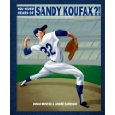
You Never Heard of Sandy Koufax?!
By Jonah Winter and Andre Carrilho
In this striking picture book biography, an old-timer tells us what made Sandy Koufax so amazing. We learn that the beginning of his career with the Brooklyn Dodgers was rocky, that he was shy with his teammates, and experienced discrimination as one of the only Jews in the game. We hear that he actually quit, only to return the next season—different—firing one rocket after another over the plate. We watch him refuse to play in the 1965 World Series because it is a Jewish high holy day. And we see him in pain because of an overused left arm, eventually retiring at the peak of his career. Finally, we are told that people are still “scratchin’ their heads over Sandy,” who remains a modest hero and a mystery to this day.
Accompanied by sidebars filled with statistics, here’s a book sure to delight budding baseball fans.
Description from Publisher
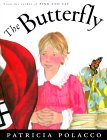
The Butterfly
Lying in bed one moonlit night, Monique awakens to see what she
thinks is a little ghost sitting at the foot of her bed, petting
her cat. In the time that her French village has been occupied by
Nazi troops, Monique has come to believe that nothing can surprise
her anymore. But when she discovers that the little ghost is in
fact a Jewish girl named Sevrine, who is living in a hidden room
in Monique's own basement, she is very surprised indeed! The two
become secret friends, whispering and giggling late at night after
their families have gone to bed. An unfortunate and alarming moment
of discovery by a neighbor forces the girls to reveal their
friendship to Monique's mother, who has been harboring Sevrine's
family and others throughout the Nazi occupation.
Based on the true experiences of the author's great aunt, Marcel
Solliliage, this poignant story is a good introduction to the
terrors of Nazism, racism, and World War II. The emphasis is on
simple friendship and quiet heroism, with an occasional lapse into
clichéd metaphor (butterfly as symbol of freedom). Any child can
relate to the bewilderment the two friends experience in the face
of prejudice.
Description from Amazon.com
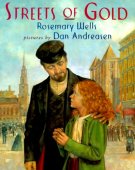
Streets of Gold
By Rosemary Wells
Masha, a young Russian girl, is terribly afraid of the czar, whose piercing
eyes glare at her from the portrait Masha's parents must keep on the wall.
In the last decade of the nineteenth century, the czar's harsh anti-Semitic
laws forbid Masha, who is Jewish, from going to school-something the
bright, inquisitive girl desperately wishes to do. When her family immigrates
to America, Masha not only achieves the long-desired education, but
also gains success as a poet, and a love for her new country that will
last all her life.
In a picture book inspired by Mary Antin's classic immigrant memoir
The
Promised Land, Rosemary Wells brings renewed vigor
and freshness to a story of the fundamental American experience. Dan
Andreasen's warm, sympathetic illustrations glow with the hope and
love that Mary finds in her new land.
Description from Publisher
Mary Antin's The
Promised Land, first published in 1912, is a classic memoir of a young Russian
Jewish immigrant who came to the U.S. in 1894. This moving picture-book
biography draws on Antin's memoir to tell a pared-down, partly fictionalized
story of her childhood: her harsh life in Russia, where the closeness of her
family sustained her through years of persecution; the difficulty of leaving
the old country; and then her new life in a Boston slum, where at 13 she found
the miracle of a free education, even for a Jewish girl. Wells' simple,
lyrical first-person narrative is true to the spirit of the original; and
with each one-page episode, she includes in the margin a quote from Antin
("I was warmed and watched over at home," she says of her family). Andreasen's
luminous, full-page oil paintings are beautiful, maybe too beautiful for this
story. The glossy, romantic scenes express little of the hardship of the
immigrant struggle, though one unforgettable picture shows racist persecution
in harsh detail--the czar's police measure Antin's brother's nose with a
ruler, since only short-nosed Jewish boys could attend school. Most moving
is Antin's celebration of education. Wells captures the excitement of the
13-year-old immigrant's first day in first grade and her almost immediate
astonishing success as a writer ("I dug the words out of my heart," Antin
said). As in Mary
on Horseback (1998), Wells has found riches in women's history. Teachers
may want to use this to introduce more of Antin's original story in the
classroom.
Description from Booklist
This book uses a picture book format to retell the story of Mary Antin. Masha Antin lives with her family in Czarist Russia in the 1800s. There are several restrictions on what Jews could do, but Masha is able to enjoy the simple pleasures with her father, such as going to the countryside and reading the five books that they owned. After the Czar's police decreed that Masha's father could no longer run his grocery store, he goes to America with hopes of finding work and bringing the rest of the family overseas. When the family was able to save enough money for the passage to America, Masha, her mother, and her brother endure an uncomfortable trip until they reach Boston where Masha's name is changed to Mary and she is able to meet up once again with her father. Life in America is very different from Russia, but Mary takes it all in stride. She pours into her studies (her first time allowed in school) and eventually writes a poem that is published in the Boston Globe. Wells treats elementary school readers to an excellent introduction to the immigration experience. The narrative is conversational yet doesn't speak down to its young readers. The thick brushstrokes in the illustrations give it a beautifully worn look. Highly recommended for teaching children about the Jewish immigration experience.
Lori's Description
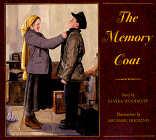
The Memory Coat
A moving story of a family emigrating to the United States from
Russia at the turn of the century. To while away the days in their
small village, or shtetl, Rachel makes up stories and her orphaned
cousin draws pictures in the dirt or snow to illustrate them. Although
Rachel's mother offers to make Grisha a new coat, the boy clings to
his threadbare jacket because it reminds him of his mother. When Russian
soldiers come to round up the Jews, the family is forced to flee and
makes the long, arduous journey to America. Grisha is nearly turned
away by immigration authorities at Ellis Island because of a cut on
his eye. Rachel saves the situation when she turns his shabby coat
inside out to hide the doctor's chalk mark. Realistic yet impressionistic
oil paintings in subdued tones evoke scenes from village and farm life
in the old country, while sepia-toned illustrations depict the hardships
of the voyage and the grimness of the customs inspection. A touching
story of immigration and the resiliency of those who underwent the
transition, told with the fondness of a cherished memory.
Description from School Library Journal
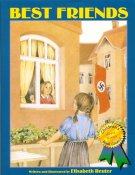
Best Friends
By Elisabeth Reuter
Awards:
Children's Choice Award
Graphically highlights what happened in 1938, when the Nazi propaganda machine began incorporating anti-Semitic doctrines within the German school system. Two children, one Jewish and the other German, are best friends until the policy at school becomes “Jews cause all the problems in Germany!”
This is the only children's book that deals with the Kristallnacht terror of 1938 when all teh synagogues and Jewish stores were vandalized. While the illustrations are start and realistic, they are neither gory nor involve concentration camps. Best Friends captures a true experience that happened to many children and reveals what German children were thinking and feeling at this time.
Description from Publisher
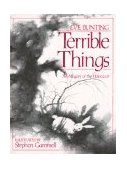
Terrible Things:
An Allegory of the Holocaust
By Eve Bunting
In this allegory, the author's reaction to the Holocaust, the animals of
the forest are carried away, one type after another, by the Terrible Things,
not realizing that if perhaps they would all stick together and not look
the other way, such terrible things might not happen.
Description from Publisher
If you are planning to introduce the Holocaust to children, picture
books make a good beginning. The most comforting books are those that
hold some kind of hope. This book is an allegory of the holocaust,
where a small questioning rabbit witnesses one animal after another
being taken from his peaceful forest.
Description from Children's Literature
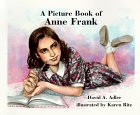
A Picture Book of Anne Frank
The life of Anne Frank serves as a microcosm of the experiences of
millions of Jews who met tragedy, torture, and death during the
Holocaust. Adler provides an excellent entry-level introduction to
this historical figure, her family, and the climate of the times. He
focuses on and explains in concise language the underlying reasons
for the family going into hiding, their lifestyle in the annex, the people
who shared their hideout, their ultimate capture, and demise (with the
exception of Mr. Frank). He conveys the liveliness and spirited
personality of the young girl through the text and the watercolor
paintings. Dissections are provided to show the living quarters and
pencil sketches depict scenes of concentration camp life. Emotions are
well expressed in this sensitive and age-appropriate portrait.
Description from School Library Journal
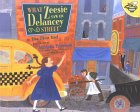
What Zeesie Saw on Delancey Street
Many picture books about early immigrant communities don't get beyond ethnic
celebration, but here there's a real story, and it grows right out of the culture. The
setting is a Jewish American community on Manhattan's Lower East Side in the
early 1900s. On her seventh birthday, Zeesie is excited to attend her first "package
party" with her parents; it's a fund-raising party where families and friends who
emigrated from the same village abroad get together and organize to bring new
immigrants to America. Priceman's gouache illustrations in folk art-style are
packed with movement, character, and color, expressing Zeesie's delight in the
foods and people and exuberant partying. But then there's a quiet moment, a
secret. There's a room at the party where the adults go in, always one at a
time. Zeesie's not supposed to enter the room, but when she does, she discovers
sorrow and also community. It's the combination of the exuberant fellowship with
the secret of individual need that makes a great story. Yiddish words, explained in
the glossary, add warmth and joyful detail, and the endpapers include two
delicious recipes.
Description from Booklist
Readers are initiated into the community revel right along with Zeesie, savoring
the toothsome dishes (glossary and two recipes included), dancing, practical
joking, and warm neighborliness. The unmistakable lesson--that it is as blessed
to receive as to give--may not be news to youngsters, but it's joyously conveyed
by Priceman's zany, dreamlike figures cavorting across bright orange backdrops
or tense and needy against somber gray. Zeesie finds 'treasure'at her first package
party, and listeners will too.
Description from Bulletin of the Center for Children's Books
Winner of The Sydney Taylor Award (Association of Jewish Libraries)
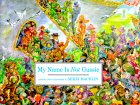
My Name is Not Gussie
By Mikki MacHlin
Golda and her family are leaving their home in Russia to embark on an
exciting journey. But why are the grownups crying? Golda doesn't
understand. All she knows is that she and her family are going to
America, where the streets are paved with gold and money grows on
trees. Soon Golda realizes that her grandparents will not be coming
with them on the voyage, but even this sad fact can not quell her
excitement for the trip. Things are as different as they possibly can be
in America. Golda soon comes to learn that there are no golden streets
in New York City, but that wishes can still come true, even in this
foreign place. This beguiling tale of the immigrant experience, told
through the eyes of a child, is sure to warm the heart of every reader.
Description from Publisher
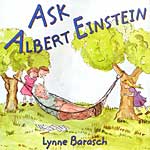
Ask Albert Einstein
By Lynne Barasch
Awards:
Natural History Magazine Best Books of the Year
Parents' Choice Award Winner
A delightful story based on an article in the New York Times in 1952. Seven-year-old April idolizes her 15-year-old sister, Annabel, who can do almost anything but has trouble with math. The teen's teacher has given her one last chance to earn a decent grade by solving a particularly difficult problem. When Annabel cries, Who does she think I am, Albert Einstein? April's curiosity and compassion for her sister result in a surprising solution to the whole dilemma, as well as to the math problem. After doing a little research about the famous scientist's life, she decides to write him a letter describing her sister's situation. He responds in an unusual, but ultimately helpful way. According to an author's note, Einstein really did find the time to go over equations with children who asked for assistance. Barasch provides a refreshing mix of genres and subjects that will appeal to many readers. The nostalgic cartoon illustrations and numerous quotes from the international figure add charm to this enchanting tale.
Description from School Library Journal
This charming picture book biography will engage young readers in the life of the brilliant scientist. Albert Einstein would frequently answer children's arithmetic, which became the basis for a New York Times article in 1952. In this fictionalized picture book based on that incident, Annabel, a struggling high school student must complete a challenging math problem in order to pass her math class. When her younger sister, April, overhears her exclaim, "Who does [the teacher] think I am, Albert Einstein?", April comes up with an idea. She copies her sister's math problem and mails it to Albert Einstein. Sure enough, a few days later, a letter appears from Einstein. While Einstein doesn't give Annabel the exact answer, he gives her a mathematical hint that helps her figure out the solution on her own. Barasch brings the human side of Albert Einstein to the forefront in this brief snippet of his life. She gives a brief background on Einstein's life to introduce readers who may not be familiar with who he is. A copy of the math problem and solution are also included, although the young readers to whom the story is directed will probably not be able to understand the higher level math problem. The whimsical watercolor-and-ink pictures enhance the lighthearted nature of this story. An excellent choice for elementary school readers.
Lori's Description
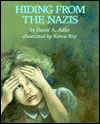
Hiding from the Nazis
By David A. Adler
Adler continues a series of picture books set during WW II with
this true account of a young Jewish child's concealment by a
family of Dutch farmers. In Ritz's potently somber watercolors,
the fears of Lore Baer, only four, come through clearly, first as
she sees soldiers arrest her grandfather, then when she is left
with a half-Christian couple by her worried parents, and finally
during her days as the "niece'' of the Schoutens, fleeing to the
next town or hiding in the barn with other fugitives whenever
searchers come. So ingrained does her fear of discovery become
that when her parents track her down two years later at war's
end, she shyly ducks out of sight and only slowly comes to trust
them again. In precise but not brutal terms, Adler briefly
describes events leading up to the occupation of the Netherlands
and the experiences of those who went into hiding, then brings
their stories up to the present in an afterword. So real and clearly
explained is Lore's anxiety that to younger readers the events
that compelled it will not seem remote at all.
Description from Kirkus Reviews
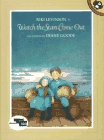
Watch the Stars Come Out
By Riki Levinson
In this warm, poignant story, a little girl hears how, long ago, another
little red-haired girl - her great-grandmother - sailed across the sea
with her older brother to join their immigrant parents in a strange
new land called America.
Description from Publisher
Awards:
- An ALA Notable Children's Book
- American Bookseller Pick of the Lists
- Booklist Children's Editors' Choice
- Parents' Choice Award for Literature
- NCTE Teachers' Choice
- NCSS/CBC Notable Children's Trade Book in the Field of Social Studies
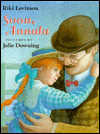
Soon, Annala
By Riki Levinson
Anna counts the days until she and her family can go to
meet the ferry that will bring her two younger brothers
to the United States. Meanwhile, she goes to school and
practices speaking English instead of Yiddish. Downing's
watercolors are full of warmth and of period details
lovingly rendered. A touching portrait of immigrant life
in the early 1900s.
Description from Horn Book
Completing the story of one family's 1910 immigration to New York
(Watch the Stars Come Out, 1985, ALA Notable), Levinson focuses on middle child Annala, who's beginning to learn English while she waits impatiently for little Sammy and Elly, left behind with Aunt Marya. At last, the great day arrives: Aunt, uncle, their new baby, and Sammy and Ella are joyfully received; that night, as the stars come out, Annala begins to teach her brother and sister to count in English. The story holds attention with its focus on the anticipated reunion and its authentic, well-integrated details of life in the new country; Downing reflects the warm, realistic tone in soft, beautifully composed watercolors--a contrast to Diane Goode's elegantly stylized art for the earlier book but appropriate.
Description from Kirkus Reviews
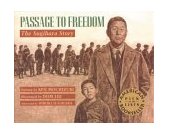
Passage to Freedom : The Sugihara Story
By Ken Mochizuki
It's July 1940, a year before the German army was ordered into Russia,
and young Hiroki Sugihara and his family are living in a small town in
Lithuania where his father is the Japanese consul. One morning, they
wake to find their house surrounded by hundreds of grim, desperate
men, women, and children shouting in Polish. Five representatives
chosen from the crowd meet with Mr. Sugihara and, with the help of a
translator, tell the frightening story of the escape of these Jews
from the Nazi soldiers in Poland. If they can get visas to travel
through the Soviet Union to Japan, they hope to go on from there to
safety. Moved by what he is told yet afraid for the safety of his own
family, Hiroki's father decides to ask the Japanese government for
permission to write the visas. Three times he sends cables, and three
times he is refused, at which point he makes a fateful decision: "I
may have to disobey my government, but if I don't, I will be
disobeying G-d." With the agreement of his family, Mr. Sugihara begins
the overwhelming task of turning out three hundred handwritten visas
a day for more than a month until he is ordered to leave Lithuania.
As their train pulls out of the station, he is still throwing permission
papers out the window to the waiting crowds. In an afterword, the real
Hiroki Sugihara describes the difficult times his family faced during
and after the war; but we also learn that his father was the first and
only Asian to receive the "Righteous Among Nations" award from the Yad
Vashem Holocaust memorial in Israel.
The haunting faces in the
illustrations in brown and sepia tones have the feeling of old photographs,
not unlike the images associated with Nazi photographs of the Holocaust.
This simple but stirring tale of courage and compassion seen through the
eyes of a child is a unique contribution to Holocaust literature for young readers.
Description from Horn Book
-"If you save the life of one person, it is as if you saved the world entire." This was the exact sentiment of the Japanese diplomat, Sugihara, and his family in Lithuania in 1941. Contrary to government orders, he issued thousands of visas to Polish Jews who became Sugihara survivors and kept their worn pieces of freedom papers as family treasures. For his selfless acts of kindness, Sugihara received the "Righteous Among Nations" Award and in Yaotsu, Japan, the Hill of Humanity is named in his honor. The Sugihara story is brief and concise, but strong and emotional. It is a story of strong belief in doing what is compassionate and right regardless of the consequences. The strong emotions emerge from the dramatic reading and interpretation by Ken Mochizuki. Children will relate to the feelings of Hiroki, the eldest son, from whose eyes the story is narrated. Respect for family, sensitivity of others, and honor toward parents emanate from the narration. Language differences when the Polish children arrive never make a barrier in play or in empathy. Listening to the story is even more dramatic than reading it. The "Afterword" adds authenticity to the story and brings the entire episode to closure. After listening, teachers can lead discussions about World War II, life-altering decisions, selflessness, compassion, and racial prejudice. This story of honor, love, and compassion presents a view of history that is seldom found in history book. It should be purchased by every public and school library.
Description from School Library Journal
This picture book biography is an excellent tribute to Chiune Sugihara, the only Asian to have received the honor of "Righteous Among Nations" by Yad Vashem. Sugihara was living in Lithuania at the dawn of WWII where he served as a Japanese ambassador. When over one hundred Jews arrived asking for a visa to save them from the Nazis, Sugihara pleaded with his government to grant the visas. After three failed attempts to get permission, Sugihara defied his government and wrote as many visas as he could until he was forced to leave Lithuania. Sepia drawings give this book the feel of an old scrapbook. The treatment of the Holocaust is tastefully done. The book is told from the perspective of Sugihara's five-year-old son, Hiroki, who only knows that if people do not get the visas, then they will die. Teachers and parents will want to bridge this story into a discussion about the Holocaust, racial prejudice, and moral decisionmaking. The book includes an afterward written by the real Hiroki Sugihara. An excellent history picture book.
Lori's Description
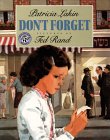
Don't Forget
Shopping in her Jewish neighborhood for ingredients to make a secret birthday cake
for her mother, Sarah meets lots of friendly people, and each storekeeper shares a
special secret for baking success. Only in the Singers' grocery store does Sarah feel
uncomfortable. They are kind to her, but she knows about their ugly secret. She tries
not to stare, but she knows that the Nazis had tattooed numbers on the arms of
Mr. and Mrs. Singer and had put the couple in a concentration camp because they
were Jews. However, the Singers insist that it isn't a secret; it must never be a secret;
otherwise, it could happen again.
Rand's soft-textured, realistic watercolors capture the postwar ethnic community in
all its richness, including the foods in the stores and the individual characters. The story
is upbeat, even sentimental: The people are all loving and gentle; everyone smiles at
Sarah, not a crotchety one among them. The quiet sorrow of the survivors is here,
and this could be a starting point for introducing the Holocaust to young children,
though the references are so oblique that adults will have to supply much more
information. What is compelling is the sense of secrets, both joyful and appalling.
Description from Booklist
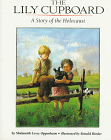
The Lily Cupboard:
A Story of the Holocaust
This story of Miriam took place in Holland during the time of the Holocaust.
But it could be the account of any Jewish children whose parents' only
way to save them from the concentration camps was to send them into
hiding. Miriam is sent away to the countryside to live with a non-Jewish
Dutch family. Sensitively told, it chronicles the wrenching good-byes that
yield to life and hope in what becomes, for Miriam, a safe haven amidst
the madness. When the German soldiers come, Miriam scurries to the
safety of the lily cupboard behind the wall. The Dutch family portrayed
here is typical of the countless families who risked their lives to hide
Jewish children during the five years of German occupation.
Description from Children's Literature
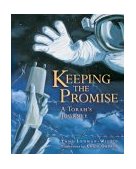
Keeping the Promise: A Torah's Journey
By Tami Lehman-Wilzig
Now in a new picture book, the touching tale of a small Torah scroll's incredible journey as it is told in Keeping the Promise. Follow the scroll as it passes from a Dutch rabbi to a Bar Mitzvah boy during the Holocaust and finally to Ilan Ramon on his tragic mission in space. This true story is a tribute to three brave men, their faith in God, and their hopes for the future.
Description from Publisher
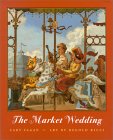
The Market Wedding
By Cary Fagan
Awards:
Sydney Taylor Honor Book
Governor General's Literary Award Finalist
His second, The Market Wedding, is an adaptation of a
100-year-old story by the American writer Abraham Cahan.
Cary took this story about Jewish immigrants in New York
and set it in the 1920s in Toronto's Kensington Market,
where his own mother grew up.
Description from Bookweek.net
The fishmonger has fallen in love with the milliner, whose
cart is across the street from his. But how is he to give
his bride the elegant home she deserves? He has a brilliant
plan: he will make their wedding so fine that surely their
friends will shower them with the best of everything. His
plan backfires, of course, but, like all good love stories,
this is a tale that ends in a happy - if surprising - fashion.
Description from Publisher
I picked up this book not for my kids but for me. The artwork
is wonderful and the story is quite endearing. It's about a
couple who work in Kensington market (in Toronto) around the
1920's. The story tells of how they meet, fall in love and
have a grand wedding. But they are simple market shop owners
of simple means. How do their friends react? Won't tell you
how it ends but it's an uplifting tale.
Description from Amazon.com Customer Review
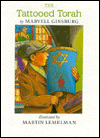
The Tattooed Torah
A small Torah stolen and desecrated by Nazi soldiers in
Czechoslovakia is eventually rescued and restored to
people who appreciate it.
Description from Publisher
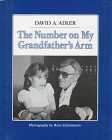
The Number on My Grandfather's Arm
A loving relationship between a young girl and her grandfather is portrayed in
text and black-and-white photographs. When the girl notices a number tattooed
on her grandfather's arm, her grandfather tells her of the atrocities committed
by the Nazis against the Jews, even describing Auschwitz, the camp he was
in. "We were no longer people to them. We were numbers.'' Moved, the young
girl comforts her grandfather.
The deceptively simple vocabulary does not limit the dignity of the text. Because
of the subject matter, this would work best when presented by an adult with
preparatory and follow-up discussion, but it offers just enough information and
emotion for primary grade children to handle. That this really happened to a
beloved grandfather makes the horror more immediate and realistic approach.
Adler has succeeded admirably in his attempt to explain the inexplicable. An
important book for everyone concerned with human rights.
Description from School Library Journal
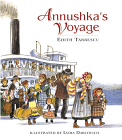
Annushka's Voyage
By Edith Tarbescu
Based on the experience of Tarbescu's mother, this picture book is a simple,
fictionalized, first-person account of the Jewish immigrant journey from Russia
to America. Papa sends steamship tickets from New York City for Anya and
her little sister, Tanya. Mama is dead, and Anya must care for her sister on the
long journey. When they leave the Russian village, Grandma gives them each a
family candlestick; on board the crowded ship, the sisters wave the candlesticks
to find each other; when they get to Papa's apartment in the immigrant
neighborhood, they light the candles for the Sabbath. Dabcovich's detailed
pen-and-ink illustrations with acrylic and colored pencil show the leaving, the
long journey over in the hold, the arrival, the terrifying medical inspections on
Ellis Island, and the warmth of their reunion with their dad. Add this to all the
immigration stories that will get younger readers interested in their own family stories.
Description from Booklist
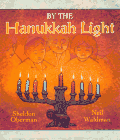
By the Hanukkah Light
A grandfather gathers his family around him, first to tell them the story of
Hanukkah and the Maccabees' victory over the Syrians. He also tells
another story of Hanukkah, his own story of persecution and hiding as a
Jew during World War II, unable to celebrate the holiday in the open for
fear of arrest. He tells how he fought the Nazis like the Maccabees fought
their oppressors. When he returns to his hometown and sees the destruction
the war has caused, he experiences his own miraclehe finds his family's
Hanukkiah (or menorah) gleaming up through the ashesa miracle as precious
to him as the miracle of the temple's oil. The man's granddaughter, Rachel,
promises to pass on the stories in just the same way to her own children.
The prose has a poetic quality, and the impressionistic artwork, done largely
in pastel shades of acrylic, serves the story well. The warm palette, the soft
focus of the rounded figures, and the effective use of shading capture the
natural light in some scenes and the illumination of the candles' flames in
others. The colored backgrounds for the double-page spreads have a dappled
look of handmade paper. Endnotes give additional information on both the
history and current traditions of Hanukkah. A solid library selection.
Description from School Library Journal
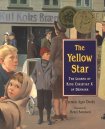
The Yellow Star: The Legend of King Christian X of Denmark
By Carmen Agra Deedy
Awards:
- 2000 Parents' Choice Gold Award
- 2002-2003 Texas Bluebonnet Award Master List
- 2001 Jane Addams Peace Association Honor Book Award
- 2001 Christopher Award, "Books for Young People Category"
- 2001 Bologna Ragazzi Award for Children's Non-Fiction
- 2001 IRA/Notable Books for a Global Society
- 2001 Notable Social Studies Trade Book for Young People, "Selector's Choice"
- 2001 ABA/Bookselling This Week: Kid's Pick of the Lists
- 2001 CBC/Combined Book Exhibit: Children's Books Mean Business
- 2001 Storytelling World Award: Stories for Adolescent Listeners
- 2000 IRA Teacher's Choice (Intermediate)
- 2000 Parent's Guide to Media Award
- Association of Jewish Libraries Notable Book for Children of 2000
For centuries, the Star of David was a symbol of Jewish pride. But during World War II, Nazis used the star to segregate and terrorize the Jewish people. Except in Denmark. When Nazi soldiers occupied his country, King Christian X of Denmark committed himself to keeping all Danes safe from harm. The bravery of the Danes and their king during that dangerous time has inspired many legends. The most enduring is the legend of the yellow star, which symbolizes the loyalty and fearless spirit of the king and his people. The result is a powerful and dignified story of heroic justice, a story for all people and all times.
Description from Publisher
Handsome double-page illustrations of Copenhagen and its residents during the Nazi-Occupation of World War II draw us into the events of a terrible time. We meet King Christian as he rides on horseback along the streets. We are with him in his office when he defies the Nazis order to fly their flag over his palace. When the edict comes that "All Jews must sew onto their clothing a yellow star," the king himself is reputed to have sewn a star on his own jacket. No one can actually corroborate this action by the King, yet it is known that no Jews within Denmark were forced to wear the yellow star, and more than 7,000 Danish Jews were smuggled to safety in Sweden during the war. The King's defiance was known throughout Europe and, factually true or legend, the story merits this straightforward retelling.
Description from Parents' Choice
Like Levine's Darkness over Denmark (reviewed on p.2023) this fiction picture book makes clear that the legend about the King of Denmark wearing a Jewish star never happened. Her focus is on the country's wise, beloved king and his support of the Jews. When the Nazis order the Jews to wear yellow stars, the king rides out on his horse wearing a star. Then the Danish people wear stars, "And once again, in the country of Denmark, there were only Danes." Sorensen's large, double-page paintings, close-up portraits and street scenes, express the strong individuality and the community of the Danish people and their bond with their leader. Henry Sorensen's pictures dramatize the confrontation between the Nazi commander and the king, as sepia scenes show the terror that is happening in Poland and elsewhere. In contrast are depictions of the warmth and strength of the Danish people going about their business. Deedy's author's note is an essential part of the book, as it distinguishes legend from fact and states the moral issue for discussion: "What if we could follow that example today against violators of human rights?"
Description from Booklist
King Christian X of Denmark was a much beloved monarch who mixed easily among his countrymen. He knew he was trusted and respected by them and shunned bodyguards or any other royal barriers between himself and his people. Stories are told of his daily rides through the city of Copenhagen and of his stalwart resistance to Nazi oppression and criminality. The legend retold here, is one in which the King risks everything--his identity, his monarchy, and his very life in an attempt to stop the Nazis from tearing apart his country and harming his people. As a model of righteousness, as a clever strategist, and as a devoted leader, King Christian X sets the standard. He deserves a legendary place in history and this elegant picture book places him there, front and center among the heroes of our times. The spare text tells the simple story with splendor and bronze-tinged full-page paintings quietly underscore the heartbreak and the majesty of the man and this legend.
Description from Children's Literature
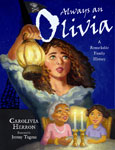
Always an Olivia: A Remarkable Family History
By Carolivia Herron
An elderly black grandmother passes on the story of the family’s Jewish origins to her young granddaughter, Carol Olivia. As family members flee the Spanish Inquisition, are kidnapped by pirates and eventually sail to America, one daughter in each generation is given the name Olivia, from the Hebrew Shulamit meaning “peace,” to honor the Jewish part of their ancestry.
Critically-acclaimed author Carolivia Herron (Nappy Hair) shares this engaging, multicultural tale is based on her own family's heritage.
Description from Publisher
Esteemed author Carolivia Herron shares the story based on her own fascinating history as a Jewish African-American. Always an Olivia is a heartwarming story of pride and family connections. Young readers will discover a unique piece of history through the eyes of young Carol Olivia as her grandmother passes on the story of her family - from one generation to another. From the Spanish inquisition to Jewish life in Portugal and Italy, Herron describes the joys and struggles of Jewish life. The youngest of readers might be alarmed when beautiful young Sarah is kidnapped by pirates, but Sarah's future brightens when one of the pirates aids in her escape. Like a real-life fairytale, they eventually fall in love and settle on the Georgia Sea Islands, among the descendants of West African slaves. Deep colored illustrations beautifully depict the characters and the scenery. Particularly noteworthy are the vibrant flowers depicted in the illustration of the Georgia Sea Islands, which contrast the darkness of the night sky when Sarah is in captivity. Herron includes a footnote of "Jews and Racial Designation," which will be of interest to teachers and students. Always an Olivia is a unique and important addition to any Jewish school or library. Although appropriate for readers as young as five, older children will be interested in the political and family history aspects of the story. This book is sure to be a favorite among teachers embarking on family genealogy projects. Highly recommended. Ages 5 and up.
Description from Jewish Book World Magazine
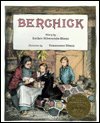
Berchick
By Esther Silverstein Blanc
Homesteading in Wyoming in the early 1900's, a Jewish mother develops an
unusual relationship with a colt she adopts named Berchick.
Description from Publisher
Winner of The Sydney Taylor Award (Association of Jewish Libraries)
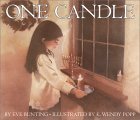
One Candle
By Eve Bunting
Every year a family celebrates Hanukkah by retelling the story of how Grandma and her sister managed to mark the day while in a German concentration camp.
Description from Publisher
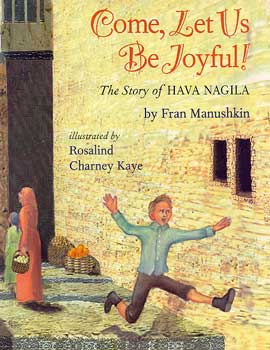
Come, Let Us Be Joyful!: The Story of Hava Nagila
By Fran Manushkin
It is a fine thing to be joyful. And is anything more joyful than coming home after a long journey? I’m going to tell you a story about a song and a journey home that took two thousand years!
So begins this charming picture book which brings to life the real history of Hava Nagila--a song that is sung at Jewish simchas and baseball games alike! Learn how this soulful, Jewish tune began while journeying towards the building of the state of Israel. Meet Professor A.Z. Idelsohn and his young student Moshe Nathanson who, by making a sad song happy, created the joyful tune of Hava Nagila. As you read this story, don't be surprised if you start humming this familiar tune along with the joyful characters that Fran Manushkin has created--the fisherman on the Red Sea, the young girls in Jaffa, the kibbutzniks around the campfire and others.
Description from Publisher
Page 1 |
Page 2 |
Page 3 |
Page 4
Still can't find what you're looking for? Search Amazon.com's database directly.
©1999-2009
(NOTE: The following links have NOT been placed on the site by the website owners. We have no control over which ads are selected and are not responsible for their religious content.)
If this page came up without frames, Click here to see the complete website
For history books for older readers, go to the History Books for Middle School and YA Readers Page
For historical fiction books for older readers, go to the Historical Fiction Books for Middle School and YA Readers Page
Other Pages of Interest:
Children's Jewish History and Historical Fiction Books
(Page 1) |
(Page 2) |
(Page 3) |
(Page 4) |
Easy Reader and Picture Books:
Jewish Children's Books (General) |
Jewish Board Books |
Biblical Stories for Children |
Jewish Holiday Books |
Jewish Family Cookbooks |
Folktales and Talmudic Stories for Children |
Jewish Life Books (Mitzvot, Keeping Kosher, etc.) |
Jewish Life Cycle Books |
Family Haggadahs |
Children's Prayerbooks |
Introductory Hebrew Books |
Jewish History and Historical Fiction Picture Books |
Israel Books
Middle School and YA Books:
Bar Mitzvah Books |
Jewish Fiction |
Historical Fiction |
Torah Study |
Prayer and Jewish Life Books |
Jewish Holidays |
Jewish Biographies |
Jewish History Books |
Holocaust Books for Teens |
Israel Books
Jewish Children's Books |
Bar Mitzvah Books |
Jewish Parenting Books |
Jewish Music for Children |
Jewish Children's Videos |
Jewish Jewelry
Other Pages of Interest:
Children's Jewish History and Historical Fiction Books
(Page 1) |
(Page 2) |
(Page 3) |
(Page 4) |
Easy Reader and Picture Books:
Jewish Children's Books (General) |
Jewish Board Books |
Biblical Stories for Children |
Jewish Holiday Books |
Jewish Family Cookbooks |
Folktales and Talmudic Stories for Children |
Jewish Life Books (Mitzvot, Keeping Kosher, etc.) |
Jewish Life Cycle Books |
Family Haggadahs |
Children's Prayerbooks |
Introductory Hebrew Books |
Jewish History and Historical Fiction Picture Books |
Israel Books
Middle School and YA Books:
Bar Mitzvah Books |
Jewish Fiction |
Historical Fiction |
Torah Study |
Prayer and Jewish Life Books |
Jewish Holidays |
Jewish Biographies |
Jewish History Books |
Holocaust Books for Teens |
Israel Books
Jewish Children's Books |
Bar Mitzvah Books |
Jewish Parenting Books |
Jewish Music for Children |
Jewish Children's Videos |
Jewish Jewelry
Easy Reader and Picture Books:
Jewish Children's Books (General) | Jewish Board Books | Biblical Stories for Children | Jewish Holiday Books | Jewish Family Cookbooks | Folktales and Talmudic Stories for Children | Jewish Life Books (Mitzvot, Keeping Kosher, etc.) | Jewish Life Cycle Books | Family Haggadahs | Children's Prayerbooks | Introductory Hebrew Books | Jewish History and Historical Fiction Picture Books | Israel Books
Middle School and YA Books:
Bar Mitzvah Books | Jewish Fiction | Historical Fiction | Torah Study | Prayer and Jewish Life Books | Jewish Holidays | Jewish Biographies | Jewish History Books | Holocaust Books for Teens | Israel Books
Jewish Children's Books | Bar Mitzvah Books | Jewish Parenting Books | Jewish Music for Children | Jewish Children's Videos | Jewish Jewelry
 You Never Heard of Sandy Koufax?! By Jonah Winter and Andre Carrilho |
In this striking picture book biography, an old-timer tells us what made Sandy Koufax so amazing. We learn that the beginning of his career with the Brooklyn Dodgers was rocky, that he was shy with his teammates, and experienced discrimination as one of the only Jews in the game. We hear that he actually quit, only to return the next season—different—firing one rocket after another over the plate. We watch him refuse to play in the 1965 World Series because it is a Jewish high holy day. And we see him in pain because of an overused left arm, eventually retiring at the peak of his career. Finally, we are told that people are still “scratchin’ their heads over Sandy,” who remains a modest hero and a mystery to this day.
Accompanied by sidebars filled with statistics, here’s a book sure to delight budding baseball fans. |
 The Butterfly |
Lying in bed one moonlit night, Monique awakens to see what she
thinks is a little ghost sitting at the foot of her bed, petting
her cat. In the time that her French village has been occupied by
Nazi troops, Monique has come to believe that nothing can surprise
her anymore. But when she discovers that the little ghost is in
fact a Jewish girl named Sevrine, who is living in a hidden room
in Monique's own basement, she is very surprised indeed! The two
become secret friends, whispering and giggling late at night after
their families have gone to bed. An unfortunate and alarming moment
of discovery by a neighbor forces the girls to reveal their
friendship to Monique's mother, who has been harboring Sevrine's
family and others throughout the Nazi occupation.
Based on the true experiences of the author's great aunt, Marcel Solliliage, this poignant story is a good introduction to the terrors of Nazism, racism, and World War II. The emphasis is on simple friendship and quiet heroism, with an occasional lapse into clichéd metaphor (butterfly as symbol of freedom). Any child can relate to the bewilderment the two friends experience in the face of prejudice. |
 Streets of Gold By Rosemary Wells |
Masha, a young Russian girl, is terribly afraid of the czar, whose piercing
eyes glare at her from the portrait Masha's parents must keep on the wall.
In the last decade of the nineteenth century, the czar's harsh anti-Semitic
laws forbid Masha, who is Jewish, from going to school-something the
bright, inquisitive girl desperately wishes to do. When her family immigrates
to America, Masha not only achieves the long-desired education, but
also gains success as a poet, and a love for her new country that will
last all her life.
In a picture book inspired by Mary Antin's classic immigrant memoir The Promised Land, Rosemary Wells brings renewed vigor and freshness to a story of the fundamental American experience. Dan Andreasen's warm, sympathetic illustrations glow with the hope and love that Mary finds in her new land. Mary Antin's The Promised Land, first published in 1912, is a classic memoir of a young Russian Jewish immigrant who came to the U.S. in 1894. This moving picture-book biography draws on Antin's memoir to tell a pared-down, partly fictionalized story of her childhood: her harsh life in Russia, where the closeness of her family sustained her through years of persecution; the difficulty of leaving the old country; and then her new life in a Boston slum, where at 13 she found the miracle of a free education, even for a Jewish girl. Wells' simple, lyrical first-person narrative is true to the spirit of the original; and with each one-page episode, she includes in the margin a quote from Antin ("I was warmed and watched over at home," she says of her family). Andreasen's luminous, full-page oil paintings are beautiful, maybe too beautiful for this story. The glossy, romantic scenes express little of the hardship of the immigrant struggle, though one unforgettable picture shows racist persecution in harsh detail--the czar's police measure Antin's brother's nose with a ruler, since only short-nosed Jewish boys could attend school. Most moving is Antin's celebration of education. Wells captures the excitement of the 13-year-old immigrant's first day in first grade and her almost immediate astonishing success as a writer ("I dug the words out of my heart," Antin said). As in Mary on Horseback (1998), Wells has found riches in women's history. Teachers may want to use this to introduce more of Antin's original story in the classroom. This book uses a picture book format to retell the story of Mary Antin. Masha Antin lives with her family in Czarist Russia in the 1800s. There are several restrictions on what Jews could do, but Masha is able to enjoy the simple pleasures with her father, such as going to the countryside and reading the five books that they owned. After the Czar's police decreed that Masha's father could no longer run his grocery store, he goes to America with hopes of finding work and bringing the rest of the family overseas. When the family was able to save enough money for the passage to America, Masha, her mother, and her brother endure an uncomfortable trip until they reach Boston where Masha's name is changed to Mary and she is able to meet up once again with her father. Life in America is very different from Russia, but Mary takes it all in stride. She pours into her studies (her first time allowed in school) and eventually writes a poem that is published in the Boston Globe. Wells treats elementary school readers to an excellent introduction to the immigration experience. The narrative is conversational yet doesn't speak down to its young readers. The thick brushstrokes in the illustrations give it a beautifully worn look. Highly recommended for teaching children about the Jewish immigration experience. |
 The Memory Coat |
A moving story of a family emigrating to the United States from
Russia at the turn of the century. To while away the days in their
small village, or shtetl, Rachel makes up stories and her orphaned
cousin draws pictures in the dirt or snow to illustrate them. Although
Rachel's mother offers to make Grisha a new coat, the boy clings to
his threadbare jacket because it reminds him of his mother. When Russian
soldiers come to round up the Jews, the family is forced to flee and
makes the long, arduous journey to America. Grisha is nearly turned
away by immigration authorities at Ellis Island because of a cut on
his eye. Rachel saves the situation when she turns his shabby coat
inside out to hide the doctor's chalk mark. Realistic yet impressionistic
oil paintings in subdued tones evoke scenes from village and farm life
in the old country, while sepia-toned illustrations depict the hardships
of the voyage and the grimness of the customs inspection. A touching
story of immigration and the resiliency of those who underwent the
transition, told with the fondness of a cherished memory.
|
 Best Friends By Elisabeth Reuter |
Awards:
Graphically highlights what happened in 1938, when the Nazi propaganda machine began incorporating anti-Semitic doctrines within the German school system. Two children, one Jewish and the other German, are best friends until the policy at school becomes “Jews cause all the problems in Germany!” This is the only children's book that deals with the Kristallnacht terror of 1938 when all teh synagogues and Jewish stores were vandalized. While the illustrations are start and realistic, they are neither gory nor involve concentration camps. Best Friends captures a true experience that happened to many children and reveals what German children were thinking and feeling at this time. |
 Terrible Things: An Allegory of the Holocaust By Eve Bunting |
In this allegory, the author's reaction to the Holocaust, the animals of
the forest are carried away, one type after another, by the Terrible Things,
not realizing that if perhaps they would all stick together and not look
the other way, such terrible things might not happen.
If you are planning to introduce the Holocaust to children, picture books make a good beginning. The most comforting books are those that hold some kind of hope. This book is an allegory of the holocaust, where a small questioning rabbit witnesses one animal after another being taken from his peaceful forest. |
 A Picture Book of Anne Frank |
The life of Anne Frank serves as a microcosm of the experiences of
millions of Jews who met tragedy, torture, and death during the
Holocaust. Adler provides an excellent entry-level introduction to
this historical figure, her family, and the climate of the times. He
focuses on and explains in concise language the underlying reasons
for the family going into hiding, their lifestyle in the annex, the people
who shared their hideout, their ultimate capture, and demise (with the
exception of Mr. Frank). He conveys the liveliness and spirited
personality of the young girl through the text and the watercolor
paintings. Dissections are provided to show the living quarters and
pencil sketches depict scenes of concentration camp life. Emotions are
well expressed in this sensitive and age-appropriate portrait.
|
 What Zeesie Saw on Delancey Street |
Many picture books about early immigrant communities don't get beyond ethnic
celebration, but here there's a real story, and it grows right out of the culture. The
setting is a Jewish American community on Manhattan's Lower East Side in the
early 1900s. On her seventh birthday, Zeesie is excited to attend her first "package
party" with her parents; it's a fund-raising party where families and friends who
emigrated from the same village abroad get together and organize to bring new
immigrants to America. Priceman's gouache illustrations in folk art-style are
packed with movement, character, and color, expressing Zeesie's delight in the
foods and people and exuberant partying. But then there's a quiet moment, a
secret. There's a room at the party where the adults go in, always one at a
time. Zeesie's not supposed to enter the room, but when she does, she discovers
sorrow and also community. It's the combination of the exuberant fellowship with
the secret of individual need that makes a great story. Yiddish words, explained in
the glossary, add warmth and joyful detail, and the endpapers include two
delicious recipes.
Readers are initiated into the community revel right along with Zeesie, savoring the toothsome dishes (glossary and two recipes included), dancing, practical joking, and warm neighborliness. The unmistakable lesson--that it is as blessed to receive as to give--may not be news to youngsters, but it's joyously conveyed by Priceman's zany, dreamlike figures cavorting across bright orange backdrops or tense and needy against somber gray. Zeesie finds 'treasure'at her first package party, and listeners will too. Winner of The Sydney Taylor Award (Association of Jewish Libraries) |

My Name is Not Gussie By Mikki MacHlin |
Golda and her family are leaving their home in Russia to embark on an
exciting journey. But why are the grownups crying? Golda doesn't
understand. All she knows is that she and her family are going to
America, where the streets are paved with gold and money grows on
trees. Soon Golda realizes that her grandparents will not be coming
with them on the voyage, but even this sad fact can not quell her
excitement for the trip. Things are as different as they possibly can be
in America. Golda soon comes to learn that there are no golden streets
in New York City, but that wishes can still come true, even in this
foreign place. This beguiling tale of the immigrant experience, told
through the eyes of a child, is sure to warm the heart of every reader.
|
 Ask Albert Einstein By Lynne Barasch |
Awards:
A delightful story based on an article in the New York Times in 1952. Seven-year-old April idolizes her 15-year-old sister, Annabel, who can do almost anything but has trouble with math. The teen's teacher has given her one last chance to earn a decent grade by solving a particularly difficult problem. When Annabel cries, Who does she think I am, Albert Einstein? April's curiosity and compassion for her sister result in a surprising solution to the whole dilemma, as well as to the math problem. After doing a little research about the famous scientist's life, she decides to write him a letter describing her sister's situation. He responds in an unusual, but ultimately helpful way. According to an author's note, Einstein really did find the time to go over equations with children who asked for assistance. Barasch provides a refreshing mix of genres and subjects that will appeal to many readers. The nostalgic cartoon illustrations and numerous quotes from the international figure add charm to this enchanting tale. This charming picture book biography will engage young readers in the life of the brilliant scientist. Albert Einstein would frequently answer children's arithmetic, which became the basis for a New York Times article in 1952. In this fictionalized picture book based on that incident, Annabel, a struggling high school student must complete a challenging math problem in order to pass her math class. When her younger sister, April, overhears her exclaim, "Who does [the teacher] think I am, Albert Einstein?", April comes up with an idea. She copies her sister's math problem and mails it to Albert Einstein. Sure enough, a few days later, a letter appears from Einstein. While Einstein doesn't give Annabel the exact answer, he gives her a mathematical hint that helps her figure out the solution on her own. Barasch brings the human side of Albert Einstein to the forefront in this brief snippet of his life. She gives a brief background on Einstein's life to introduce readers who may not be familiar with who he is. A copy of the math problem and solution are also included, although the young readers to whom the story is directed will probably not be able to understand the higher level math problem. The whimsical watercolor-and-ink pictures enhance the lighthearted nature of this story. An excellent choice for elementary school readers. |

Hiding from the Nazis By David A. Adler |
Adler continues a series of picture books set during WW II with
this true account of a young Jewish child's concealment by a
family of Dutch farmers. In Ritz's potently somber watercolors,
the fears of Lore Baer, only four, come through clearly, first as
she sees soldiers arrest her grandfather, then when she is left
with a half-Christian couple by her worried parents, and finally
during her days as the "niece'' of the Schoutens, fleeing to the
next town or hiding in the barn with other fugitives whenever
searchers come. So ingrained does her fear of discovery become
that when her parents track her down two years later at war's
end, she shyly ducks out of sight and only slowly comes to trust
them again. In precise but not brutal terms, Adler briefly
describes events leading up to the occupation of the Netherlands
and the experiences of those who went into hiding, then brings
their stories up to the present in an afterword. So real and clearly
explained is Lore's anxiety that to younger readers the events
that compelled it will not seem remote at all.
|
 Watch the Stars Come Out By Riki Levinson |
In this warm, poignant story, a little girl hears how, long ago, another
little red-haired girl - her great-grandmother - sailed across the sea
with her older brother to join their immigrant parents in a strange
new land called America.
Awards:
|
 Soon, Annala By Riki Levinson |
Anna counts the days until she and her family can go to
meet the ferry that will bring her two younger brothers
to the United States. Meanwhile, she goes to school and
practices speaking English instead of Yiddish. Downing's
watercolors are full of warmth and of period details
lovingly rendered. A touching portrait of immigrant life
in the early 1900s.
Completing the story of one family's 1910 immigration to New York (Watch the Stars Come Out, 1985, ALA Notable), Levinson focuses on middle child Annala, who's beginning to learn English while she waits impatiently for little Sammy and Elly, left behind with Aunt Marya. At last, the great day arrives: Aunt, uncle, their new baby, and Sammy and Ella are joyfully received; that night, as the stars come out, Annala begins to teach her brother and sister to count in English. The story holds attention with its focus on the anticipated reunion and its authentic, well-integrated details of life in the new country; Downing reflects the warm, realistic tone in soft, beautifully composed watercolors--a contrast to Diane Goode's elegantly stylized art for the earlier book but appropriate. |

Passage to Freedom : The Sugihara Story By Ken Mochizuki |
It's July 1940, a year before the German army was ordered into Russia,
and young Hiroki Sugihara and his family are living in a small town in
Lithuania where his father is the Japanese consul. One morning, they
wake to find their house surrounded by hundreds of grim, desperate
men, women, and children shouting in Polish. Five representatives
chosen from the crowd meet with Mr. Sugihara and, with the help of a
translator, tell the frightening story of the escape of these Jews
from the Nazi soldiers in Poland. If they can get visas to travel
through the Soviet Union to Japan, they hope to go on from there to
safety. Moved by what he is told yet afraid for the safety of his own
family, Hiroki's father decides to ask the Japanese government for
permission to write the visas. Three times he sends cables, and three
times he is refused, at which point he makes a fateful decision: "I
may have to disobey my government, but if I don't, I will be
disobeying G-d." With the agreement of his family, Mr. Sugihara begins
the overwhelming task of turning out three hundred handwritten visas
a day for more than a month until he is ordered to leave Lithuania.
As their train pulls out of the station, he is still throwing permission
papers out the window to the waiting crowds. In an afterword, the real
Hiroki Sugihara describes the difficult times his family faced during
and after the war; but we also learn that his father was the first and
only Asian to receive the "Righteous Among Nations" award from the Yad
Vashem Holocaust memorial in Israel.
The haunting faces in the illustrations in brown and sepia tones have the feeling of old photographs, not unlike the images associated with Nazi photographs of the Holocaust. This simple but stirring tale of courage and compassion seen through the eyes of a child is a unique contribution to Holocaust literature for young readers. -"If you save the life of one person, it is as if you saved the world entire." This was the exact sentiment of the Japanese diplomat, Sugihara, and his family in Lithuania in 1941. Contrary to government orders, he issued thousands of visas to Polish Jews who became Sugihara survivors and kept their worn pieces of freedom papers as family treasures. For his selfless acts of kindness, Sugihara received the "Righteous Among Nations" Award and in Yaotsu, Japan, the Hill of Humanity is named in his honor. The Sugihara story is brief and concise, but strong and emotional. It is a story of strong belief in doing what is compassionate and right regardless of the consequences. The strong emotions emerge from the dramatic reading and interpretation by Ken Mochizuki. Children will relate to the feelings of Hiroki, the eldest son, from whose eyes the story is narrated. Respect for family, sensitivity of others, and honor toward parents emanate from the narration. Language differences when the Polish children arrive never make a barrier in play or in empathy. Listening to the story is even more dramatic than reading it. The "Afterword" adds authenticity to the story and brings the entire episode to closure. After listening, teachers can lead discussions about World War II, life-altering decisions, selflessness, compassion, and racial prejudice. This story of honor, love, and compassion presents a view of history that is seldom found in history book. It should be purchased by every public and school library. This picture book biography is an excellent tribute to Chiune Sugihara, the only Asian to have received the honor of "Righteous Among Nations" by Yad Vashem. Sugihara was living in Lithuania at the dawn of WWII where he served as a Japanese ambassador. When over one hundred Jews arrived asking for a visa to save them from the Nazis, Sugihara pleaded with his government to grant the visas. After three failed attempts to get permission, Sugihara defied his government and wrote as many visas as he could until he was forced to leave Lithuania. Sepia drawings give this book the feel of an old scrapbook. The treatment of the Holocaust is tastefully done. The book is told from the perspective of Sugihara's five-year-old son, Hiroki, who only knows that if people do not get the visas, then they will die. Teachers and parents will want to bridge this story into a discussion about the Holocaust, racial prejudice, and moral decisionmaking. The book includes an afterward written by the real Hiroki Sugihara. An excellent history picture book. |
 Don't Forget |
Shopping in her Jewish neighborhood for ingredients to make a secret birthday cake
for her mother, Sarah meets lots of friendly people, and each storekeeper shares a
special secret for baking success. Only in the Singers' grocery store does Sarah feel
uncomfortable. They are kind to her, but she knows about their ugly secret. She tries
not to stare, but she knows that the Nazis had tattooed numbers on the arms of
Mr. and Mrs. Singer and had put the couple in a concentration camp because they
were Jews. However, the Singers insist that it isn't a secret; it must never be a secret;
otherwise, it could happen again.
Rand's soft-textured, realistic watercolors capture the postwar ethnic community in all its richness, including the foods in the stores and the individual characters. The story is upbeat, even sentimental: The people are all loving and gentle; everyone smiles at Sarah, not a crotchety one among them. The quiet sorrow of the survivors is here, and this could be a starting point for introducing the Holocaust to young children, though the references are so oblique that adults will have to supply much more information. What is compelling is the sense of secrets, both joyful and appalling. |
 The Lily Cupboard: A Story of the Holocaust |
This story of Miriam took place in Holland during the time of the Holocaust.
But it could be the account of any Jewish children whose parents' only
way to save them from the concentration camps was to send them into
hiding. Miriam is sent away to the countryside to live with a non-Jewish
Dutch family. Sensitively told, it chronicles the wrenching good-byes that
yield to life and hope in what becomes, for Miriam, a safe haven amidst
the madness. When the German soldiers come, Miriam scurries to the
safety of the lily cupboard behind the wall. The Dutch family portrayed
here is typical of the countless families who risked their lives to hide
Jewish children during the five years of German occupation.
|
 Keeping the Promise: A Torah's Journey By Tami Lehman-Wilzig |
Now in a new picture book, the touching tale of a small Torah scroll's incredible journey as it is told in Keeping the Promise. Follow the scroll as it passes from a Dutch rabbi to a Bar Mitzvah boy during the Holocaust and finally to Ilan Ramon on his tragic mission in space. This true story is a tribute to three brave men, their faith in God, and their hopes for the future.
|
 The Market Wedding By Cary Fagan |
Awards: Sydney Taylor Honor Book Governor General's Literary Award Finalist His second, The Market Wedding, is an adaptation of a 100-year-old story by the American writer Abraham Cahan. Cary took this story about Jewish immigrants in New York and set it in the 1920s in Toronto's Kensington Market, where his own mother grew up. The fishmonger has fallen in love with the milliner, whose cart is across the street from his. But how is he to give his bride the elegant home she deserves? He has a brilliant plan: he will make their wedding so fine that surely their friends will shower them with the best of everything. His plan backfires, of course, but, like all good love stories, this is a tale that ends in a happy - if surprising - fashion. I picked up this book not for my kids but for me. The artwork is wonderful and the story is quite endearing. It's about a couple who work in Kensington market (in Toronto) around the 1920's. The story tells of how they meet, fall in love and have a grand wedding. But they are simple market shop owners of simple means. How do their friends react? Won't tell you how it ends but it's an uplifting tale. |
 The Tattooed Torah |
A small Torah stolen and desecrated by Nazi soldiers in
Czechoslovakia is eventually rescued and restored to
people who appreciate it.
|
 The Number on My Grandfather's Arm |
A loving relationship between a young girl and her grandfather is portrayed in
text and black-and-white photographs. When the girl notices a number tattooed
on her grandfather's arm, her grandfather tells her of the atrocities committed
by the Nazis against the Jews, even describing Auschwitz, the camp he was
in. "We were no longer people to them. We were numbers.'' Moved, the young
girl comforts her grandfather.
The deceptively simple vocabulary does not limit the dignity of the text. Because of the subject matter, this would work best when presented by an adult with preparatory and follow-up discussion, but it offers just enough information and emotion for primary grade children to handle. That this really happened to a beloved grandfather makes the horror more immediate and realistic approach. Adler has succeeded admirably in his attempt to explain the inexplicable. An important book for everyone concerned with human rights. |
 Annushka's Voyage By Edith Tarbescu |
Based on the experience of Tarbescu's mother, this picture book is a simple,
fictionalized, first-person account of the Jewish immigrant journey from Russia
to America. Papa sends steamship tickets from New York City for Anya and
her little sister, Tanya. Mama is dead, and Anya must care for her sister on the
long journey. When they leave the Russian village, Grandma gives them each a
family candlestick; on board the crowded ship, the sisters wave the candlesticks
to find each other; when they get to Papa's apartment in the immigrant
neighborhood, they light the candles for the Sabbath. Dabcovich's detailed
pen-and-ink illustrations with acrylic and colored pencil show the leaving, the
long journey over in the hold, the arrival, the terrifying medical inspections on
Ellis Island, and the warmth of their reunion with their dad. Add this to all the
immigration stories that will get younger readers interested in their own family stories.
|
 By the Hanukkah Light |
A grandfather gathers his family around him, first to tell them the story of
Hanukkah and the Maccabees' victory over the Syrians. He also tells
another story of Hanukkah, his own story of persecution and hiding as a
Jew during World War II, unable to celebrate the holiday in the open for
fear of arrest. He tells how he fought the Nazis like the Maccabees fought
their oppressors. When he returns to his hometown and sees the destruction
the war has caused, he experiences his own miraclehe finds his family's
Hanukkiah (or menorah) gleaming up through the ashesa miracle as precious
to him as the miracle of the temple's oil. The man's granddaughter, Rachel,
promises to pass on the stories in just the same way to her own children.
The prose has a poetic quality, and the impressionistic artwork, done largely
in pastel shades of acrylic, serves the story well. The warm palette, the soft
focus of the rounded figures, and the effective use of shading capture the
natural light in some scenes and the illumination of the candles' flames in
others. The colored backgrounds for the double-page spreads have a dappled
look of handmade paper. Endnotes give additional information on both the
history and current traditions of Hanukkah. A solid library selection.
|
 The Yellow Star: The Legend of King Christian X of Denmark By Carmen Agra Deedy |
Awards:
For centuries, the Star of David was a symbol of Jewish pride. But during World War II, Nazis used the star to segregate and terrorize the Jewish people. Except in Denmark. When Nazi soldiers occupied his country, King Christian X of Denmark committed himself to keeping all Danes safe from harm. The bravery of the Danes and their king during that dangerous time has inspired many legends. The most enduring is the legend of the yellow star, which symbolizes the loyalty and fearless spirit of the king and his people. The result is a powerful and dignified story of heroic justice, a story for all people and all times.
Handsome double-page illustrations of Copenhagen and its residents during the Nazi-Occupation of World War II draw us into the events of a terrible time. We meet King Christian as he rides on horseback along the streets. We are with him in his office when he defies the Nazis order to fly their flag over his palace. When the edict comes that "All Jews must sew onto their clothing a yellow star," the king himself is reputed to have sewn a star on his own jacket. No one can actually corroborate this action by the King, yet it is known that no Jews within Denmark were forced to wear the yellow star, and more than 7,000 Danish Jews were smuggled to safety in Sweden during the war. The King's defiance was known throughout Europe and, factually true or legend, the story merits this straightforward retelling. Like Levine's Darkness over Denmark (reviewed on p.2023) this fiction picture book makes clear that the legend about the King of Denmark wearing a Jewish star never happened. Her focus is on the country's wise, beloved king and his support of the Jews. When the Nazis order the Jews to wear yellow stars, the king rides out on his horse wearing a star. Then the Danish people wear stars, "And once again, in the country of Denmark, there were only Danes." Sorensen's large, double-page paintings, close-up portraits and street scenes, express the strong individuality and the community of the Danish people and their bond with their leader. Henry Sorensen's pictures dramatize the confrontation between the Nazi commander and the king, as sepia scenes show the terror that is happening in Poland and elsewhere. In contrast are depictions of the warmth and strength of the Danish people going about their business. Deedy's author's note is an essential part of the book, as it distinguishes legend from fact and states the moral issue for discussion: "What if we could follow that example today against violators of human rights?" King Christian X of Denmark was a much beloved monarch who mixed easily among his countrymen. He knew he was trusted and respected by them and shunned bodyguards or any other royal barriers between himself and his people. Stories are told of his daily rides through the city of Copenhagen and of his stalwart resistance to Nazi oppression and criminality. The legend retold here, is one in which the King risks everything--his identity, his monarchy, and his very life in an attempt to stop the Nazis from tearing apart his country and harming his people. As a model of righteousness, as a clever strategist, and as a devoted leader, King Christian X sets the standard. He deserves a legendary place in history and this elegant picture book places him there, front and center among the heroes of our times. The spare text tells the simple story with splendor and bronze-tinged full-page paintings quietly underscore the heartbreak and the majesty of the man and this legend. |
 Always an Olivia: A Remarkable Family History By Carolivia Herron |
An elderly black grandmother passes on the story of the family’s Jewish origins to her young granddaughter, Carol Olivia. As family members flee the Spanish Inquisition, are kidnapped by pirates and eventually sail to America, one daughter in each generation is given the name Olivia, from the Hebrew Shulamit meaning “peace,” to honor the Jewish part of their ancestry.
Critically-acclaimed author Carolivia Herron (Nappy Hair) shares this engaging, multicultural tale is based on her own family's heritage. Esteemed author Carolivia Herron shares the story based on her own fascinating history as a Jewish African-American. Always an Olivia is a heartwarming story of pride and family connections. Young readers will discover a unique piece of history through the eyes of young Carol Olivia as her grandmother passes on the story of her family - from one generation to another. From the Spanish inquisition to Jewish life in Portugal and Italy, Herron describes the joys and struggles of Jewish life. The youngest of readers might be alarmed when beautiful young Sarah is kidnapped by pirates, but Sarah's future brightens when one of the pirates aids in her escape. Like a real-life fairytale, they eventually fall in love and settle on the Georgia Sea Islands, among the descendants of West African slaves. Deep colored illustrations beautifully depict the characters and the scenery. Particularly noteworthy are the vibrant flowers depicted in the illustration of the Georgia Sea Islands, which contrast the darkness of the night sky when Sarah is in captivity. Herron includes a footnote of "Jews and Racial Designation," which will be of interest to teachers and students. Always an Olivia is a unique and important addition to any Jewish school or library. Although appropriate for readers as young as five, older children will be interested in the political and family history aspects of the story. This book is sure to be a favorite among teachers embarking on family genealogy projects. Highly recommended. Ages 5 and up. |
 Berchick By Esther Silverstein Blanc |
Homesteading in Wyoming in the early 1900's, a Jewish mother develops an
unusual relationship with a colt she adopts named Berchick.
Winner of The Sydney Taylor Award (Association of Jewish Libraries) |
 One Candle By Eve Bunting |
Every year a family celebrates Hanukkah by retelling the story of how Grandma and her sister managed to mark the day while in a German concentration camp.
|
 Come, Let Us Be Joyful!: The Story of Hava Nagila By Fran Manushkin |
It is a fine thing to be joyful. And is anything more joyful than coming home after a long journey? I’m going to tell you a story about a song and a journey home that took two thousand years!
So begins this charming picture book which brings to life the real history of Hava Nagila--a song that is sung at Jewish simchas and baseball games alike! Learn how this soulful, Jewish tune began while journeying towards the building of the state of Israel. Meet Professor A.Z. Idelsohn and his young student Moshe Nathanson who, by making a sad song happy, created the joyful tune of Hava Nagila. As you read this story, don't be surprised if you start humming this familiar tune along with the joyful characters that Fran Manushkin has created--the fisherman on the Red Sea, the young girls in Jaffa, the kibbutzniks around the campfire and others. |